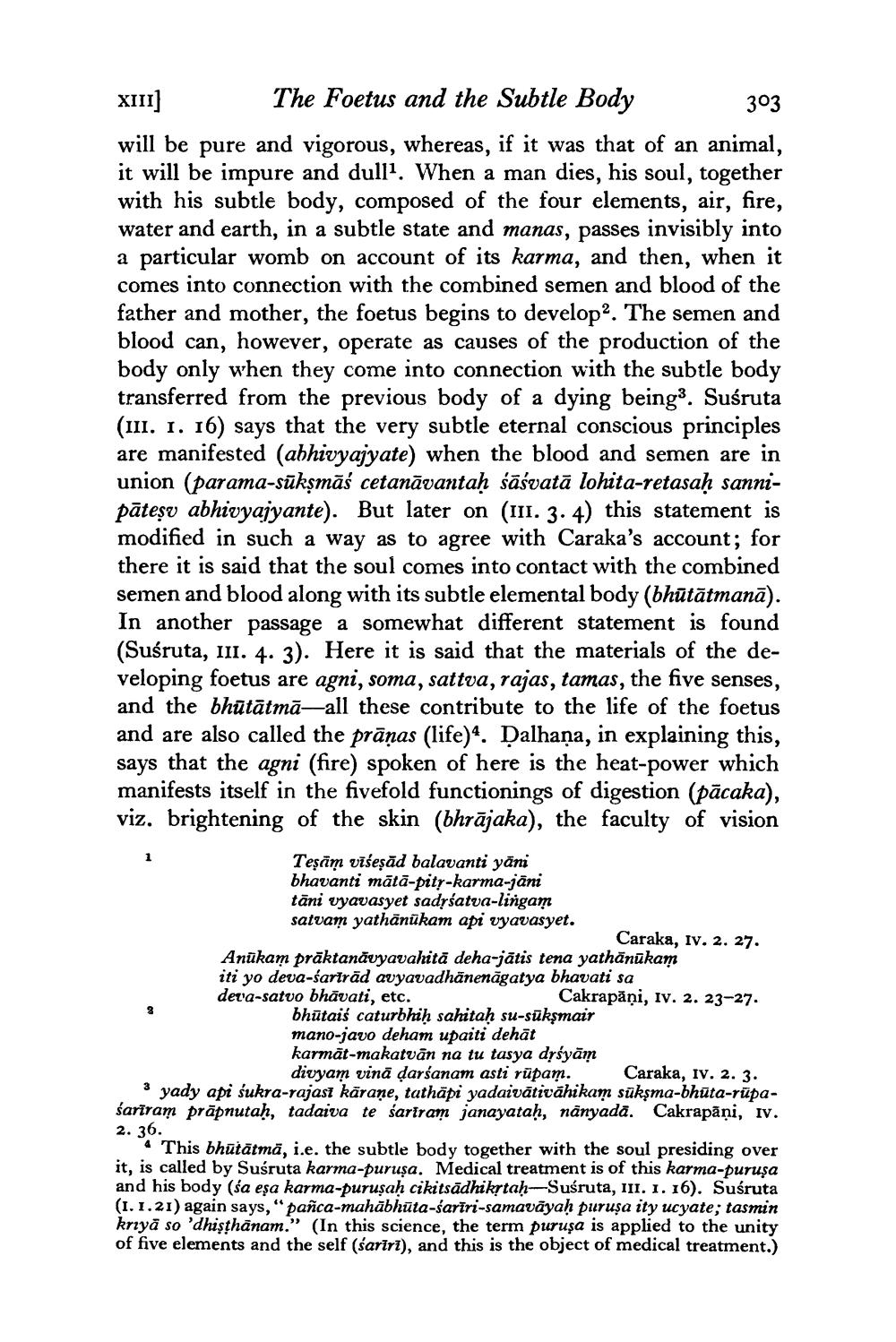________________
XIII]
The Foetus and the Subtle Body
303
will be pure and vigorous, whereas, if it was that of an animal, it will be impure and dull1. When a man dies, his soul, together with his subtle body, composed of the four elements, air, fire, water and earth, in a subtle state and manas, passes invisibly into a particular womb on account of its karma, and then, when it comes into connection with the combined semen and blood of the father and mother, the foetus begins to develop2. The semen and blood can, however, operate as causes of the production of the body only when they come into connection with the subtle body transferred from the previous body of a dying being3. Suśruta (III. I. 16) says that the very subtle eternal conscious principles are manifested (abhivyajyate) when the blood and semen are in union (parama-sūkṣmāś cetanāvantaḥ śāśvatā lohita-retasaḥ sannipāteṣv abhivyajyante). But later on (III. 3. 4) this statement is modified in such a way as to agree with Caraka's account; for there it is said that the soul comes into contact with the combined semen and blood along with its subtle elemental body (bhūtātmanā). In another passage a somewhat different statement is found (Suśruta, III. 4. 3). Here it is said that the materials of the developing foetus are agni, soma, sattva, rajas, tamas, the five senses, and the bhūtātmā-all these contribute to the life of the foetus and are also called the prānas (life)4. Dalhana, in explaining this, says that the agni (fire) spoken of here is the heat-power which manifests itself in the fivefold functionings of digestion (pacaka), viz. brightening of the skin (bhrājaka), the faculty of vision
1
Teṣām viseṣād balavanti yāni bhavanti mātā-pity-karma-jāni tāni vyavasyet sadṛśatva-lingam satvam yathānūkam api vyavasyet.
Caraka, Iv. 2. 27.
Anūkam prāktanāvyavahitā deha-jātis tena yathānūkam iti yo deva-sarträd avyavadhänenägatya bhavati sa deva-satvo bhāvati, etc.
Cakrapāņi, Iv. 2. 23-27.
bhūtais caturbhiḥ sahitaḥ su-sükṣmair mano-javo deham upaiti dehat karmat-makatvan na tu tasya dṛśyām divyam vină ḍarśanam asti rūpam. Caraka, IV. 2. 3. 3 yady api śukra-rajast kärane, tathāpi yadaivātivāhikam sūkṣma-bhūta-rupasariram prapnutah, tadaiva te sariram janayataḥ, nanyadā. Cakrapāņi, IV. 2. 36.
This bhūtātmā, i.e. the subtle body together with the soul presiding over it, is called by Suśruta karma-purușa. Medical treatment is of this karma-puruşa and his body (sa eşa karma-puruṣaḥ cikitsadhikṛtaḥ-Suśruta, III. 1. 16). Suśruta (1.1.21) again says, "pañca-mahabhūta-sariri-samavayaḥ puruşa ity ucyate; tasmin kriya so 'dhiṣṭhānam." (In this science, the term puruşa is applied to the unity of five elements and the self (sariri), and this is the object of medical treatment.)




